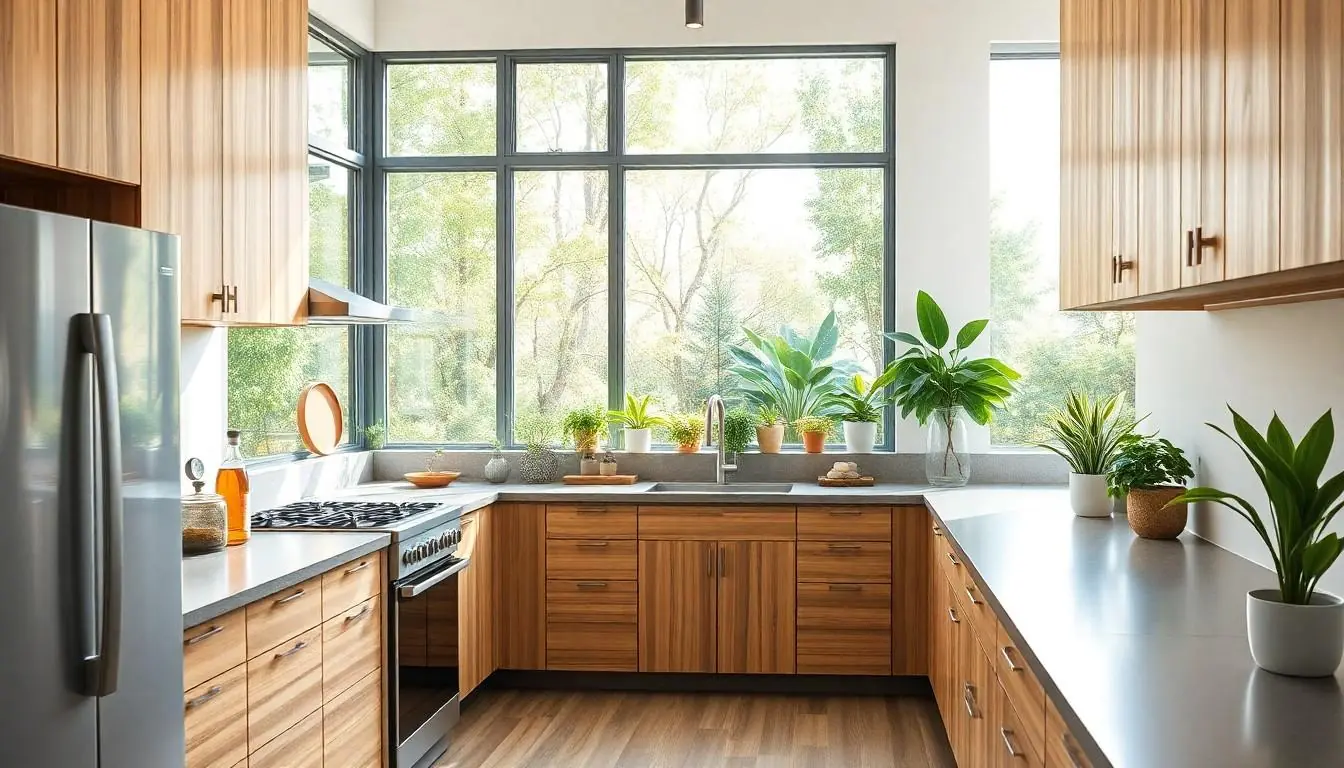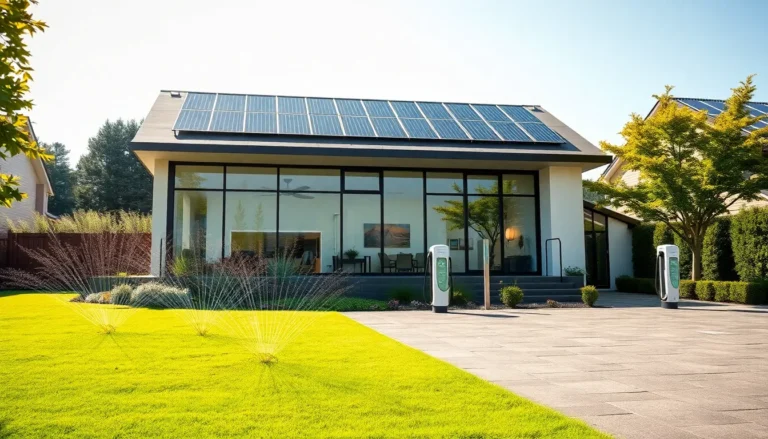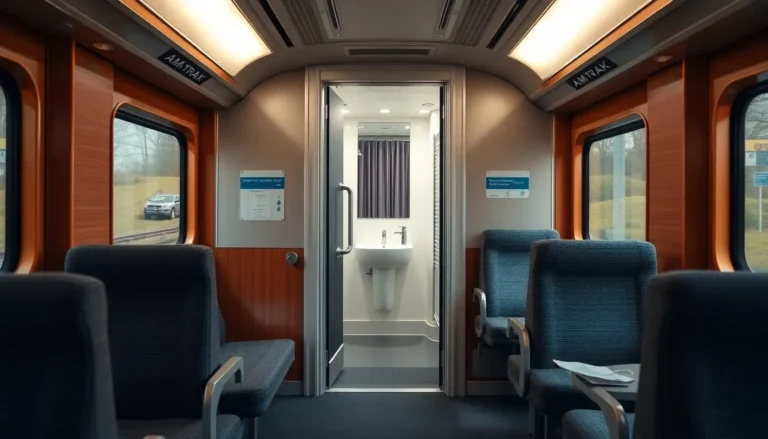Imagine turning your home into a cozy eco-paradise while saving the planet and maybe even a few bucks. Green home remodeling isn’t just a trend; it’s a lifestyle choice that makes Mother Earth smile. With every bamboo floorboard and energy-efficient window, homeowners can strut their stuff while reducing their carbon footprint. Who knew saving the environment could be so stylish?
Table of Contents
ToggleWhat Is Green Home Remodeling?
Green home remodeling encompasses eco-friendly renovations aimed at enhancing sustainability while improving the quality of living spaces. This approach prioritizes materials and practices that reduce environmental impact, focusing on energy efficiency and resource conservation. Homeowners opt for features like solar panels, which provide renewable energy and cut utility costs, ultimately lowering their carbon footprint.
Sustainable materials play a critical role in green remodeling. Bamboo flooring and recycled glass countertops highlight the aesthetic appeal while minimizing resource depletion. Additionally, low-VOC paints and finishes improve indoor air quality, creating a healthier environment for residents.
Energy-efficient appliances are vital components of eco-friendly renovations. They consume less power compared to standard models, offering long-term savings and reducing energy demands. Upgrading to smart home technology enables better energy management, allowing homeowners to monitor and control usage remotely.
Water conservation also remains a significant focus. Low-flow faucets, dual-flush toilets, and efficient irrigation systems reduce water waste while maintaining functionality. Implementing these changes contributes to a reduced environmental impact both in and outside the home.
Green home remodeling isn’t merely a trend; it represents a shift towards more sustainable living practices. Homeowners gain the flexibility to express their style while committing to responsible choices that benefit the planet. Long-term savings, enhanced comfort, and healthier living spaces underscore the value of embracing eco-friendly renovations.
Benefits of Green Home Remodeling

Green home remodeling offers significant advantages that enhance both quality of life and environmental health. Homeowners experience a range of benefits, including lowered utility bills and improved indoor air quality.
Environmental Impact
Green remodeling minimizes ecological footprints while promoting sustainability. Using eco-friendly materials like recycled wood or bamboo reduces deforestation and waste. Homeowners contribute to clean air by choosing low-VOC paints that lower indoor pollution. Implementing water-saving fixtures decreases overall consumption, positively affecting local water supplies. Incorporating solar panels generates renewable energy, further diminishing reliance on fossil fuels. Together, these choices support a healthier planet for future generations.
Energy Efficiency
Enhancing energy efficiency is a primary benefit of green home remodeling. Energy-efficient appliances save electricity, which translates into cost savings on utility bills. Homeowners often install double-glazed windows, improving insulation and keeping homes comfortable. Smart home technology allows for better energy management, reducing wasteful consumption. Upgrading heating and cooling systems also leads to significant energy savings. By embracing these improvements, homeowners enjoy increased comfort and reduced environmental impact.
Health Considerations
Health improvements represent a vital aspect of green home remodeling. Sustainable building materials contribute to better indoor air quality, reducing allergens and toxins. Choosing non-toxic paints and finishes supports a healthier living environment. Increased natural light from energy-efficient windows enhances mood and well-being. Alongside this, proper ventilation systems diminish humidity and mitigate mold growth. Eco-friendly spaces support not only physical health but also mental well-being, contributing to an overall improved lifestyle.
Key Strategies for Green Home Remodeling
Green home remodeling emphasizes sustainable practices that enhance both the environment and living spaces. Homeowners can make impactful changes by prioritizing eco-friendly materials and methods.
Sustainable Materials
Sustainable materials play a crucial role in green remodeling projects. Bamboo flooring, recycled glass countertops, and reclaimed wood are excellent examples. These materials not only reduce waste but also offer unique aesthetics. Choosing low-VOC paints ensures better indoor air quality, contributing to healthier living environments. Incorporating insulation made from recycled denim or cellulose minimizes energy consumption. Opting for sustainable materials lowers the carbon footprint associated with new constructions.
Energy-Efficient Appliances
Energy-efficient appliances significantly decrease overall energy use. Selecting ENERGY STAR rated devices leads to lower utility bills and reduced environmental impact. Examples include refrigerators, washing machines, and dishwashers designed to consume less power while maintaining performance. Smart home technology enables homeowners to optimize energy management effectively. These appliances often come with advanced features that enhance convenience, such as predictive energy usage. Transitioning to energy-efficient appliances ensures both immediate and long-term savings.
Water Conservation Techniques
Water conservation techniques are essential for sustainable home remodeling. Installing low-flow faucets and showerheads can dramatically reduce water usage without sacrificing comfort. Employing rainwater harvesting systems provides an alternative water source for irrigation. Efficient irrigation systems, like drip irrigation, target the roots of plants directly, minimizing waste. Crafting xeriscaped gardens promotes drought-resistant plants, further conserving water. Implementing these techniques contributes to overall environmental sustainability while lowering water bills.
Planning Your Green Home Remodel
Effective planning is essential for a successful green home remodel. This approach ensures sustainable practices while maximizing aesthetics and functionality.
Budgeting for Sustainability
Establishing a budget focused on sustainability starts with prioritizing eco-friendly materials and technologies. Allocating funds for energy-efficient appliances, such as those rated ENERGY STAR, can lead to significant long-term savings. Setting aside a portion of the budget for quality installations ensures durability in sustainable materials, such as reclaimed wood or bamboo flooring. Understanding local incentives for renewable energy installations, like solar panels, helps stretch the budget further. Homeowners should examine potential cost-saving measures that align with their sustainability goals to maximize financial benefits.
Choosing the Right Contractors
Selecting the right contractors influences the success of a green remodel. Prioritize professionals with proven experience in eco-friendly renovations and sustainable building practices. Checking references and portfolios helps gather insights into their past work and specialization. Assessing certification and training in green building standards ensures contractors align with sustainability goals. Effective communication with potential contractors allows homeowners to express their vision and confirm familiarity with eco-friendly materials and techniques. Investing in skilled contractors promotes energy efficiency and supports a positive remodeling experience.
Challenges and Considerations
Green home remodeling presents unique challenges and considerations that homeowners face throughout the process. Understanding these elements helps in making informed decisions.
Cost vs. Long-term Savings
Initial costs for sustainable materials and energy-efficient technologies often seem high. Over time, homeowners notice substantial savings on utility bills that offset those upfront expenses. Energy-efficient appliances can reduce energy consumption by up to 50%, translating into lower monthly bills. Many eco-friendly features also enhance home resale value, further justifying the investment. Analyzing total cost versus long-term savings encourages homeowners to weigh the benefits of choosing sustainable alternatives.
Local Regulations and Permits
Compliance with local regulations is vital when pursuing green remodeling projects. Building codes and zoning laws differ by location, which affects the types of renovations permitted. Homeowners need to research specific regulations before beginning any project. Some areas also offer permits for renewable energy installations or water conservation systems, which can provide financial incentives. To ensure compliance, engaging local authorities early in the planning process simplifies obtaining necessary permits and approvals.
Embracing green home remodeling is a powerful way to enhance living spaces while making a positive impact on the environment. By prioritizing sustainable materials and energy-efficient technologies, homeowners can enjoy reduced utility bills and improved indoor air quality. The journey toward an eco-friendly home not only showcases personal style but also contributes to a healthier planet for future generations.
With careful planning and the right professionals, the challenges of green remodeling can be effectively navigated. This approach represents a commitment to sustainability that benefits both the homeowner and the world around them. Investing in eco-friendly renovations is not just a trend; it’s a responsible choice that paves the way for a brighter future.


